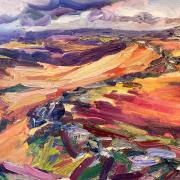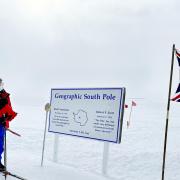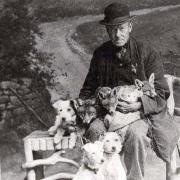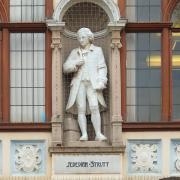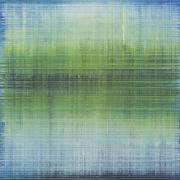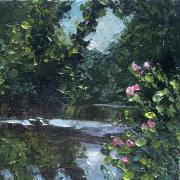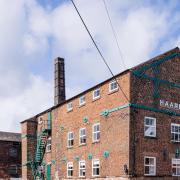Dating back to the 1890s, Viyella – ‘the first branded fabric in the world’ – is a name indelibly linked to Derbyshire’s clothing industry. As Pat Ashworth discovers, a third-generation family connection is helping to breathe new life into the business.

YOU could say it all began with the Romans and the beautiful ravine at Cromford that became the Via Gellia. William Hollins and Company, spinners and hosiers, bought a mill there in 1890 and gave the name Viyella to the fabric they had been developing over at Pleasley, where they’d set up a factory in 1784. And then they decided they could be more innovative if they made finished garments from the cloth instead of just shipping it all over the world... and so they started to make shirts.
Steve McConnell, sales director of the company that is now the European licensee of the Viyella brand – the Riddings-based M2C2 – is wearing one this morning. It’s a dark and miserable winter’s day outside and the glowing colours on their cream background present a sight somehow warming and reassuring as he opens the door. His Scottish grandfather worked for 35 years for what was then Coats Threads and his father, Jim, rose to run various divisions of the company after starting as a mail boy at the age of 16, distributing post to all departments over the 15 floors of the Coats building in Paisley.
In 1971, the family moved down to Derbyshire. ‘It was like emigration,’ Steve says with a broad smile. He joined the company in 1985 and worked in the Fabric Division but then spent 20 years in the construction industry before returning six months ago to do what he says ‘is absolutely ingrained in me.’ Viyella has had a turbulent recent history following a series of mergers, de-mergers and buyouts that began in the early 1960s but plans for the future are exciting and the business is very much destined to grow from its Derbyshire headquarters.
What William Hollins and Company uniquely did, says managing director Neal Dawson, was to blend each fibre of wool and cotton yarns together before the dyeing process. That continues to this day. ‘Dye takes better to the wool element, so we can get the depth of colour that no-one else can get. Wool is a hollow fibre; cotton is a dead yarn with no elasticity or stretch. The colour within wool is richer and deeper,’ he observes. The ratio of wool to cotton was 55 to 45 in those early days: now, in our times, it’s 80 per cent cotton and 20 per cent wool – but it’s the wool that makes all the difference, once you put it next to your skin.

‘You see in this business all sorts of brands trying to create some history, some kind of provenance. We have a brand here that’s steeped in history. In my head, when I’m sat at home at night, I think, “I’m the custodian of the Crown Jewels,”’ Neal reflects. ‘We, this management team, are looking after these brands and one day we’ll pass it on to the next generation.’
The table is piled with archive material, including big, leather-bound ledgers of marketing materials. There’s a lovely advertisement from the mid-20th century showing a country gentleman wearing a Viyella shirt and standing against the background of a stately home. The strapline is, ‘Englishmen have been known to inherit them.’
‘We work at finding new approaches but all the answers actually go back in history,’ Steve says cheerfully. ‘Look at this marketing slogan – “It’s warm when it’s not. It’s cool when it’s hot”. Nothing’s changed there.’
We chuckle over the glamorous, adoring housewives – ‘Super to iron, darling…’ We pore over swatch books from 1935, with vibrant colours that set the place alight. There’s a machinists’ training manual from 1948 recommending that juveniles come straight into the factory and just ‘run about’ at first doing all kinds of jobs. There are mountains of photographs that illustrate just how big an enterprise the British clothing industry was – Ken Dodd is seen performing to thousands of Viyella staff at a company awards ceremony.

Viyella’s big Somercotes factory, now demolished, stood just half a mile away from the Riddings HQ. In an age of cheap, throwaway clothing, there’s a need to get back to appreciating textiles, Neal suggests. ‘The high street shopping experience has changed so dramatically. We used to pick up garments, feel them, try them on. We’re adapting to new markets and embracing online trading but our challenge is not just to put our beautiful product on the table and say to the independent retailers we’re in alliance with now, “What would you like to buy?” It’s to understand how we adapt what we do to suit them, to help them offer an experience the consumer will enjoy in-store.’
The Viyella checked shirt with its heathery, country colours became almost a uniform for the country fraternity that embraced it from the start. It was designed as an action shirt, a functional shirt, longer at the back and with room to manoeuvre in, ‘a fashionable shirt but a practical garment’, Neal suggests. ‘Our challenge is getting the younger consumer to understand those quality virtues, to invest in something that will see them through several seasons – so when we took them to a game fair last year, we were delighted that so many men between 21 and 30 were happy to find Viyella shirts and were grabbing them off the rails.’
‘Colour, colour and colour is what it’s all about,’ says Steve. 18 months investment goes into a new design, all done in-house at Riddings, and they’re currently working on designs for autumn and winter 2019. This Derbyshire company is optimistic about the future, despite the tendency of the younger British man for seeking volume at a lower price rather than having a good piece of clothing.
‘We are not the cheapest shirt and we know it but it will last for years and years and won’t go out of fashion,’ Steve says. ‘There are a lot of people moving away from a disposable culture, there’s a big appetite for that.’ He is loving being back in textiles – ‘We have to enjoy what we’re doing. It’s a passion and you can’t teach that.’ Neal agrees, ‘It comes from within. You can’t get away from where Viyella came from and what it stands for: there’s a uniqueness about that. We have a responsibility to ensure its longevity and survival for the future, with the modern day attributes we have today.

‘Steve’s father, Jim, is still chairman of the Board. We use him as our conscience. Sometimes being firm about your core and your heritage is what you have to do. Occasionally we find ourselves pushing against the trend and that can prove to be the right course of action.’
Viyella’s roots are proudly displayed on every shirt button, where the name and the date of 1784 are engraved. ‘All the buttons are positioned by hand as the garment is manufactured. You’ll never find it upside down or twisted from left to right – it’s just a tiny example of the TLC that goes into making sure that our attributes, our passion, our energy and love and enthusiasm come through to the finished item,’ Neal reflects. ‘We could cut the corner and they could make 10 more an hour, but just think of a Rolls-Royce car hand-sewn in leather on the dashboard...’
One old strapline was ‘Then. Now. Forever.’ Viyella is a three-generation thing, the pair and indeed the new marketing suggest. And Steve’s 15-year-old son has already done some work experience here. ‘We gave him a day in each area. Two McConnells with their sandwich boxes started together,’ he says. ‘So we’re lining up the next generation as well...’






